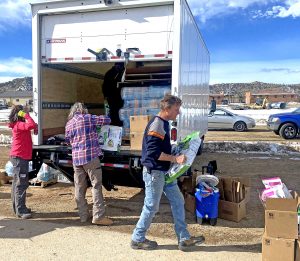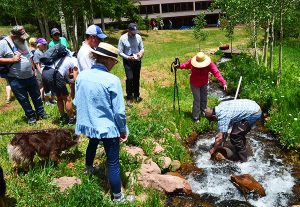by Nancy Christofferson
HUERFANO- Stop me if you know this one. See, there’s this gang of banditos ridin’ hard to reach a favorite curve on the railroad, knowing the engineer will have to slow down to make the turn, and the gang can board and have their way with the money on board. They complete the dirty deed and gallop off into the brush.
The telegrapher gets off a quick message, and the railroad detective gathers a posse. Horses are loaded into a baggage car, the posse, fully armed, boards and heads south to confront the banditos, and – what, you’ve seen the movie?
The most important thing about this scenario is that it actually was factual, and our Huerfano County sheriff loomed large in the action.
The sheriff probably loomed large anyway, because he was a Farr, and the Farrs weren’t known to be scrawny. This was Sheriff Edward Farr who, on the fateful day of July 11, 1899, was asked to ride with a small group of lawmen to capture four train robbers who, earlier in the day, had robbed the Colorado and Southern Railroad near Folsom. Farr stepped onto the next southbound and joined railroad special agent W.H. Reno in Trinidad. From there they traveled over Raton Pass and were joined by five Colfax County deputies. Once the horses were unloaded in Raton, the posse headed toward Cimarron where Black Jack was known to have a hideout.
The posse members assumed they were chasing the gang of Black Jack Ketchum, which they were, sort of. Black Jack, or Thomas Edward Ketchum, had been born in Texas in 1863 but went to the Pecos Valley in New Mexico when in his ‘20s and took up cowboying. He was joined there by his brother Sam, and the duo robbed their first train in 1892. The following year Black Jack, who got his nickname by being mistaken for someone else, may or may not have murdered a man, but a price was put on his head, and he continued to follow the outlaw trail. He and Sam then robbed a post office, never a good idea, and killed several members of the posse that tracked them, an even worse idea. The Ketchum boys now had rewards posted for them, and lawmen all over the Territory of New Mexico and far southeastern Colorado were on the lookout. The brothers were no strangers to any type of crime, and they became quite well known by reputation and sight.
Black Jack and Sam had no taste in cohorts. Two of these were Bill Carver and Elza “Elzy” Lay, both former members of the Hole in the Wall gang and accomplices of Butch Cassidy. Both were cold blooded killers. Another man believed to be riding with the gang was named McGinnis, but he may not have been an actual person because Lay’s favorite alias was William McGinnis. Carver went by the name G.W. Franks. This profligate use of aliases causes no end of confusion. Sam was the only one who used his own name. Perhaps he had no imagination.
So the posse is scouring the mesas and valleys of northeastern New Mexico, searching for Black Jack, but the joke’s on them. Black Jack is meanwhile minding his own business far away. He knew nothing of the robbery, he later claimed. History records the train robbers were Sam, Carver, Lay and a McGinnis.
The lawmen caught up with the robbers in Turkey Creek Canyon near Cimarron. A gunfight ensued and Sam was shot in the arm. The gang escaped, assisting Sam.
Sam’s injury slowed down the bad guys, and they were discovered the next day near their original position in Turkey Creek Canyon. Another gunfight broke out. In this one, the banditos gained the upper hand, shooting Deputy W.H. Love dead and grievously wounding Farr in the hip. It was all a matter of the choice of powder. The villains of the piece had wisely selected smokeless powder, while the underpaid lawman were carrying the old fashioned powder. Because of this, the bandits could see the puffs of smoke and identify the location of where the shots originated, and the lawmen had no clue as to where the bullets were coming from. The banditos used the knowledge well, and to deadly effect.
Farr was in a bad way with a nasty shattered hip. He died two days later. He had been sheriff for three years. He was elected in 1898 but evidently had taken over the office in 1896 after the infamous Italian Massacre (another story for another day), which left five dead and caused the previous sheriff, on whose watch the five Italians died, to join the list of the unemployed.
Sam Ketchum was still in great pain with his injured arm. Gangrene set in and he died a few weeks later. His cronies rode on.
Now comes Black Jack. In complete ignorance of any recent robbery or shootouts, old B.J. decides to rob a train. You got it – he robs the train on Aug. 16 in the same spot his brother had held it up. A vigilant conductor recognized him and spread the word after shooting him in the arm with a shotgun. Black Jack was soon captured. He was taken to the hospital in Trinidad where his arm was amputated, and then incarcerated in the Clayton, NM, jail.
Black Jack sat around his cell for some long months. He finally was put on trial and found guilty of attempted train robbery. With luck as bad as his timing of train robberies, he became the only person ever executed for this crime in New Mexico, because the law concerning attempted train robbery was found unconstitutional.
Black Jack’s death on the gallows on April 16, 1901 is well known. He lost his head, literally. It seems those long days in jail had caused a mighty big appetite, and he’d gained considerable weight. Though he faced death bravely, uttering words of bravado that vary wildly in their repetition, he met a very bad end when his head was separated from his body. It was sewn back on and he was buried in Clayton.
None of Black Jack’s supposedly immortal words followed him. His tombstone has an inscription reading “And How His Audit Stands Who Knows Save Heaven”, which was probably not his first choice of wording.
Ed Farr was buried in Walsenburg’s Masonic Cemetery with services by the Woodmen of the World. The Pictou band played. If only his relatives had attended, it must have been a large funeral, for Ed was one of 12 children. He was born Nov. 22, 1867 in Kerrville, TX, so was just 34 years old when he was killed. After his death the county commissioners promoted one of his deputies, brother Jefferson B. Farr, to sheriff, bypassing Undersheriff W.H. Farmer. Ed and Jeff had come to Huerfano County in 1880, and Ed was the second sheriff of the county to be murdered.
In April 1901 Sheriff Jeff heard two of Black Jack’s gang had been shot and killed in Texas. One of these was Bill Carver, alias G.W. Franks. The McGinnis involved in the infamous C&S train robbery was said to have been killed as well, but Elzy Lay, alias William McGinnis, lived until 1934 and was known as the last survivor of the Wild Bunch.

Breaking news: Results of Walsenburg Mayor race and recall election
Gary M. Vezzani was elected Walsenburg’s mayor in Tuesday’s special mayoral election/recall vote. Preliminary results announced Tuesday night show that both Nick Vigil in Ward



